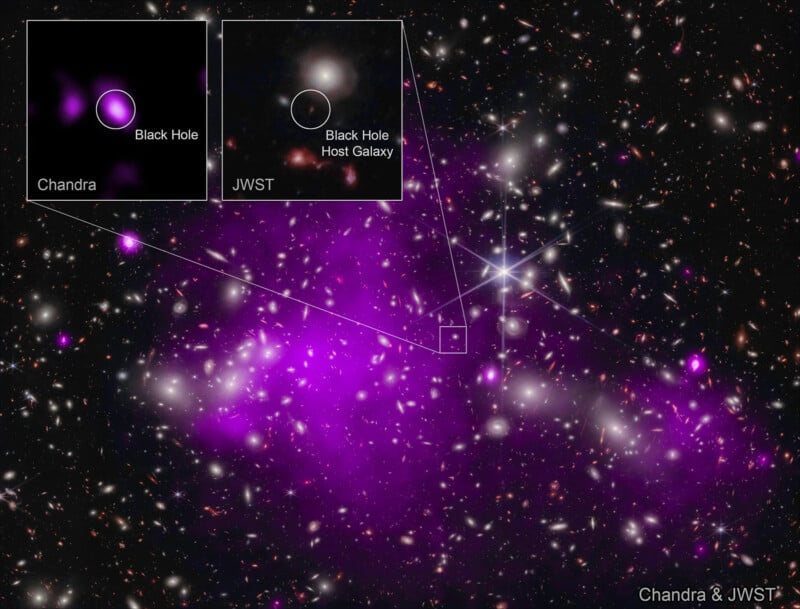
By combining data from NASA’s Chandra X-ray Observatory and the James Webb Space Telescope, astronomers have discovered the most distant black hole ever detected in X-rays.
In a galaxy called UHZ1, astronomers have spotted the “telltale signature” of a growing black hole a mere 470 million years following the Big Bang.
“We needed Webb to find this remarkably distant galaxy and Chandra to find its supermassive black hole,” explains Akos Bogdan of the Center for Astrophysics | Harvard & Smithsonian (CfA), who leads a new paper in the journal Nature Astronomy describing these results. “We also took advantage of a cosmic magnifying glass that boosted the amount of light we detected.”
The magnifying effect is also known as “gravitational lensing,” which is when the gravitational effects of large concentrations of mass can bend and magnify the light from distant galaxies behind a massive object. Gravitational lensing is vital for scientists studying distant, early galaxies like UHZ1.
UHZ1 is located in the direction of the galaxy cluster Abell 2744 and is 3.5 billion light-years from Earth. However, thanks to Webb’s extreme resolving capabilities, scientists have determined that while in the same direction as Abell 2744, UHZ1 is much further away, 13.2 billion light-years away. The light arriving from UHZ1 is from when the universe was only about 3% of its current age.
Over two weeks of observations using the Chandra X-ray Observatory, astronomers observed “intense, superheated, X-ray emitting gas” in UHZ1, a “trademark for a growing supermassive black hole.” The light from the galaxy and the X-rays from the gas surrounding its supermassive black hole are magnified by a factor of about four thanks to the matter in Abell 2744, which enhances the infrared signal detected by Webb and enables Chandra to detect X-ray emissions from UHZ1 at all.
The remarkable discovery is critical for scientists trying to understand how supermassive black holes can form and attain such tremendous mass so soon after the Big Bang.
“Do they form directly from the collapse of massive clouds of gas, creating black holes weighing between about 10,000 and 100,000 Suns? Or do they come from explosions of the first stars that create black holes weighing only between about 10 and 100 Suns?” asks a NASA press release.
“There are physical limits on how quickly black holes can grow once they’ve formed, but ones that are born more massive have a head start. It’s like planting a sapling, which takes less time to grow into a full-size tree than if you started with only a seed,” says Andy Goulding of Princeton University. Goulding is a co-author of the Nature Astronomy paper and lead author of a new research paper in The Astrophysical Journal Letters that uses a spectrum from Webb to demonstrate the galaxy’s distance.
Bogdan’s team has discovered compelling evidence that the supermassive black hole in UHZ1 was “born massive.” Based on the brightness and energy of the emitted X-rays, the black hole’s mass is estimated to be somewhere between 10 and 100 million Suns.
This is extremely exciting because that mass is similar to that of all the stars in its galaxy combined. Typically, black holes in the centers of galaxies relatively closer to the Milky Way galaxy have a mass equal to about 0.1% of the mass of that galaxy’s stars.
The supermassive black hole in UHZ1 is fascinating not just for its mass but because it is the first instance of what co-author Priyamvada Natarajan of Yale University calls an “Outside Black Hole.” Natarajan theorized that such a black hole could develop from a collapse of a huge cloud of gas, and now there is evidence for the hypothesis.
This discovery is just the latest in what is sure to be a very long list of groundbreaking research concerning the early universe that Webb helps deliver.
